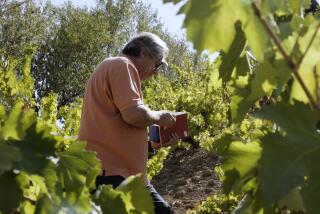Greece is the word in white wines for summer

- Share via
A few months ago, a wine made its way into my glass that was so far outside my wheelhouse it haunted me long after the bottle was empty. It was a Greek wine, a terse, piney Roditis called Petra made by Kir-Yianni winery from a region called Florina, in the mountains near the Greek border with Albania and Macedonia -- which is to say somewhere between anywhere and nowhere. I savored this enigmatic wine, its scents of lime and pine frond, its flavors of fennel and quince, its brisk, almost salty, acidity.
So it is with Greece, a vaguely mysterious country where the food and wine have always been familiar to Americans and yet slightly outside our grasp. For years, Greek wines were rarely seen here beyond the walls of Greek restaurants, and the country’s viticultural output was unfairly represented by medicinal, resin-tinged Retsina, one of the more archaic, not to say weird, modern evocations of ancient tradition.
But like many of its Mediterranean and Eastern European neighbors, Greece has modernized its winemaking, improved its viticulture and devoted itself to the many indigenous varieties that have been cultivated for thousands of years. These varieties, with lyrical names like Assyrtiko, Malagousia, Agiorghitiko and Xinomavro, are finally gaining recognition for being at once exotic and world class.
After years of spotty distribution, they’ve finally made their way to California retail shelves. Crisp, exotic, herbal and thirst-quenching, they’re ideal for your summer table.
Like Italy, Greece has vines growing just about everywhere. The country is responsible for an incalculable number of bottlings, but most are consumed within a few hundred yards of the vineyards from which they come. As Mike Greene, general manager at Woodland Hills Wine Co. in Woodland Hills and a frequent visitor to Greece, explained to me, with the astonishing amount of wine that is made, bottled and sold by taverna owners to locals there -- who needs an export market?
The taverna connection gives an idea of the place wine occupies in traditional Greek culture. When Greeks want a drink, they reach for ouzo, the fiery anise spirit. The notion of wine as an aperitif is somewhat foreign. On the other hand, they wouldn’t dream of having a meal without it.
Lean reds, whites
THIS accounts in part for the shared traditional styles of the whites and the reds, both of which tend to be lean, low in extract (or density), low in alcohol and high in acid or tannin -- ideal for the country’s rustic, at times heavy, cuisine. It’s hard to imagine taking a bite of bubbling saganaki (flaming cheese) or a rich, feta-laced spanakopita without having a bracing wine alongside to cleanse the palate.
Historically, of course, Greece’s 4,000-year-old wine culture is one of the world’s most important and significant. Most of the rest of Europe traces its winemaking tradition back to Greece. The country exported wine and viticultural know-how first to Italy and Sicily, then to France and Spain, and on to Turkey, Georgia, Macedonia, Bulgaria, even Switzerland.
Wine played a cherished role in classical Greek culture. It was a central feature of feasts and celebrations, it was used in religious rituals, and even in symposiums, where it was said to provide clarity and spiritual awareness.
Each of the cultures that fell under the considerable influence of Greek civilization drew from this reverence for wine.
It’s sometimes hard to conjure up a mental picture of the map of Greece with its thousands of islands, its semidetached linkage to the Balkan Peninsula and its irregular shape extending like a many-fingered hand into the Aegean.
But in terms of wines exported, there are roughly three broad areas upon which to focus: northern Greece, which includes the important appellations of Naousa and Thessaloniki; the southernmost part of mainland Greece , consisting largely of the Peloponnese and appellations such as Nemea and Mantinia; and the southern islands, the most important of which is Santorini.
Greece winemakers have been experimenting with globally familiar grape varieties such as Syrah, Viognier and Sauvignon Blanc. But I’d recommend sticking with the indigenous varieties; after all, when a country has grown wine grapes for 40 centuries, you’d expect that it’d learned a thing or two about what works and where.
In the jumble of climatic conditions that crisscross the country, what links Olympus to Crete is heat, and the ancient varieties are best equipped to withstand torrid summer temperatures and paltry rainfall.
A resilient grape
NONE shows better resilience than Assyrtiko, the crystalline white grape that somehow thrives on the scorching wind-swept hillsides of Santorini. Assyrtiko is found in other regions, but Santorini is considered the ideal locale for the grape. These wines are lean, lemony and angular, with a fierce, high-toned minerality supporting bright citrus flavors, ideal for grilled squid and light, lemony salads.
A second white grape finding its way to California shelves is Moschofilero, a pink-skinned variety that is most successfully grown on high-elevation vineyards in the mountains of Mantinia in the Peloponnese. Mantinia is where Boutari, one of the country’s largest wineries, bottles a superb one. Moschofilero has a Muscat-like floral scent and is sometimes made into a pleasing sparkling wine.
Its flavors can possess an almost pineapple ripeness, but they’re always buoyed by a healthy acidity. That additional richness can support an even richer seafood dish, such as grilled striped bass, grouper or even octopus.
Roditis, the source of my Greek wine epiphany, is one of the oldest-known continuously cultivated indigenous varieties in Greece. Roditis is found all over the country; it is often blended with the lesser variety Savatiano for everyday table wine.
Roditis varies widely in quality, but when planted in higher elevations and at higher latitudes -- like Florina, the source of Kir-Yianni’s Petra -- the wine gains focus and precision. I had this wine with sea scallops, which were seared at high heat and served on a bed of pea sprouts.
Malagousia amounts to one of the great finds in recent years among indigenous white varieties in Greece. In 1976, University of Thessaloniki professor of viticulture Vassilis Logothetis leased land at a winery in Thessaloniki, where he propagated a variety of indigenous vines he had collected, including Malagousia.
The winemaker there, Evangelos Gerovassiliou, soon recognized that these vines produced exceptional fruit, and after some experimentation, he released a varietal Malagousia in the early ‘90s.
Malagousia is that rare Greek white grape that lends itself to barrel fermentation and wood aging, and the wines, which are still quite rare here, are simply spectacular.
Gerovassiliou’s remains the finest, a mélange of pear and lees, with plenty of body, supported by well-integrated oak, and a structure that could complement salmon or char beautifully.
Opposing reds
WITH the heat of July upon us, Greece’s whites deserve the lion’s share of attention. But two of the many red grapes the country has to offer, Agiorghitiko and Xinomavro, are so vivid and marvelous they’re worth examining. The varieties represent a kind of yin and yang for Greek reds.
To my mind, Agiorghitiko closely resembles Tuscan Sangiovese, and in certain bottlings produced in its most natural home, Nemea, in the Peloponnese, it resembles Vino Nobile di Montepulciano. One example: the Driopi bottling from Tselepos. It’s hard to imagine a more natural wine for lamb.
If Agiorghitiko is the powerhouse red of Greece, Xinomavro is its more delicate counterpart. Many compare the grape to Pinot Noir, but to my palate it more closely resembles a slightly less tannic version of Nebbiolo.
It is worth finding one with a little bottle age, like the Naoussa Xinomavro “Grande Reserve” from Boutari, whose current release is 2003; it is the wine you want alongside your next plate of moussaka.
More to Read
Sign up for Essential California
The most important California stories and recommendations in your inbox every morning.
You may occasionally receive promotional content from the Los Angeles Times.













